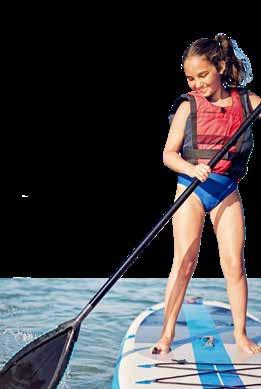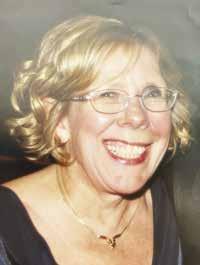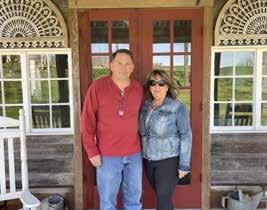
14 minute read
AGING IN PLACE
Story by Linda Learman | Photos by Nanci Heiney
Bill and Diane Rouser
THERE’S NO PLACE LIKE HOME.
In their 1965 hit song “My Generation,” the rock band The Who sang “I hope I die before I get old.” Now in their late 70s and preparing to go on tour this year, The Who may be singing a slightly different tune.
In recent years, original band members Roger Daltry and Pete Townshend have required hearing aids to keep playing their music. Just like the rest of us, even rock stars are finding some form of disability can come with age, but it doesn’t have to mean the end of what we know and love – or where we live.
Take longtime Adrian residents Diane and Bill Rauser, for example. Diane said that about a year ago the couple started talking about how aging may eventually change their housing needs, and they wanted to be proactive about it. The decision they eventually settled on is an increasingly popular choice called “aging in place,” but it wasn’t an immediately apparent one.
“We are the baby boomers,” said Diane, “and I said to my husband Bill one day, ‘Which nursing home did you want to go into if you fall and break your hip?’ And he was like, ‘What?!’ But I said, ‘No, I’m serious. We have a two-story house, and the stairs are steep, and if anything were to happen, there’s no way I’m running up and down those stairs to take care of you, so which nursing home would it be?’”
That conversation, which she retells with humor in the way long-married couples sometimes rib each other, hit home enough that it became, she said, “the impetus for us to start looking for single-story, one family homes.”
But there was also a truth in her jest: Diane’s elderly mother had lived with the couple for a time in their lowerlevel bedroom that had its own bath. “She had everything she
needed, but all she had to do was get up the stairs [to the main floor],” Diane said. “Well, it was awful because she was falling, and you can’t live like that. So that was probably on the back of my mind.”
The Rausers knew they wanted to stay in Adrian, but the more they looked, the more discouraged they became. “We couldn’t find anything that we thought would work for us,” Diane said. Not only were there few options available for their needs, but even fewer options checked the boxes for their wants.
Thirty-three years ago, in 1989, the Rausers built their home in Adrian on what Diane calls their “idyllic, magnificent setting.” They put in a deck and a swimming pool, raised their three children, and eventually grandchildren came along, too. Diane, who owns the SASS gift store in downtown Adrian, sometimes has her 15-year-old granddaughter help in the store after school. “We have a big family, and we get together all the time,” she said. Their home was rich with memories that were still being made.
The Rausers didn’t want to leave their home, but they didn’t see how they could stay. “We looked at all the options, but nothing made sense,” Diane said. “We couldn’t imagine our life outside of that house, but we knew we had to do something.” They weren’t alone in their thinking. A 2018 AARP survey showed that almost 80% of older adults want to maintain their independence and live in their own home as long as possible, but fewer than 50% think it will be feasible.
As the challenges of finding a new place to live mounted, the help of some friends came in. Diane had invited realtor Sherry Beaubien over to get some suggestions on how to renovate their only first-floor bathroom, a half-bath, if they were to stay in the house. She said Sherry offered a few ideas but then told her, “What you really need is an architect.”
Enter Brenda Rigdon. “Good thing you knew one,” interjected Brenda, principal of Black Raven Architects in Adrian. Diane laughed with a vigorous nod. “In general, in the home industry, there was a huge boom [in renovations], with people suddenly realizing with COVID, especially, what if one of us gets sick, what if we have to isolate, or have mobility issues? It was a wake-up call for a lot of people,” said Brenda. “We really want to help find solutions for people like Bill and Diane so they can stay in the house they’ve been in and not have to deal with a big disruption in their lives.”
Staying in one’s home in senior years with a consistent and even improved quality of life is the main idea of aging in place. But as Brenda’s comments suggest, aging in place doesn’t mean merely staying put. It requires careful planning for accessibility and safety and involves a clear-eyed examination of physical, emotional, social, and financial needs and resources.
When Bill and Diane initially began thinking about how they might stay in their home, they considered adding on a first-floor bedroom and bathroom. “But the cost was almost prohibitive,” Diane said. Friends and family offered well-meaning suggestions, but it wasn’t until they met with Brenda that the Rausers came to see how their existing space could be customized in ways that would suit them now, in the future, and would make

The newly expanded eat-in kitchen made better sense than a rarely-used formal dining room.

their home more open, accessible, and ADA (Americans with Disabilities Act) friendly. “That’s been the important thing, the ADA stuff,” Diane said. “Basically, the entire back half of the first floor has been renovated, with the exception of the kitchen, though it was expanded.”
First floor halls and doorways were widened to accommodate a wheelchair or walker. Adding an elevator was considered, but the couple ultimately decided against it. Diane said, “You have to decide what you’re giving up when you do some things, and we just decided the elevator wasn’t going to be an option for us.”
The Rausers’ home already had a main-floor laundry, but their seldomused formal dining room was repurposed to make way for a full bath. The elimination of the dining room, in turn, allowed for a three-foot expansion of the existing eat-in kitchen. The first-floor study was converted into a bedroom, with a redesigned closet that houses a desk and computer as well as a TV that can be adjusted to watch from the bed. Double doors were installed so the newly renovated area on the first floor can be closed off into a private suite with a living room, bedroom, and ADA compliant bathroom. The door to the bathroom has a five-foot radius so a wheelchair can be turned around inside, and a vanity was installed with wheelchair accessibility. The walk-in shower has grab bars, a builtin seat, a handheld showerhead, and room enough for one person to assist another.
But possible mobility issues aren’t the only considerations for aging in place. “We practically doubled the amount of lighting in our house because as you get older you don’t see as well. We were already noticing it, and we’re not even old yet,” said Diane.
“It’s a real issue if you start tripping on things on the floor because you’re not seeing that well,” added Brenda. The Rausers eliminated hallway rugs that had once covered wood floors and, except for the carpeted living room, replaced most of the flooring in their house with new non-slip luxury vinyl tile.
As an architect, Brenda understands building codes and ADA standards; as a mother, she has “a heightened perspective to ADA issues,” she said, as her adult daughter has spent her entire life in a wheelchair. But Brenda

Eliminating the formal dining area also made room for a wheelchair accessible bathroom. View of the pool from the kitchen doorway.

is also quick to credit Claire Watson and Amanda Clipper, recent Adrian College graduates, for their assistance with the Rauser project. Claire was an intern at the time helping with field work and basic design, while Amanda had been hired by Black Raven Architects as an interior designer.
“We did 3-D renderings to show [the Rausers] what it would look like with the materials that they wanted to use so that it
was consistent with the rest of the house, finding things that don’t slip and make it easier to maneuver around,” Brenda said.
The Rausers were able to live in their house with minor inconvenience while all the renovations took place, according to Diane. “Every single detail, [Rigdon] laid it out for us to do, and we did it,” she said.
Diane loves the new changes and how they accommodate her life right now. Of the expanded kitchen, she said, “I got a much bigger area for a table and bought the biggest table I could find. And I got the coolest thing… a custom space with shelves for all my platters, napkins, and paper plates, and with a light so I can see everything. And the shelves were reused from the former study. I love coming in every day and looking at that table and knowing my whole family can eat in that room together now.”
“You couldn’t do that if you had moved into a condo,” said Brenda. “We’re all about reusing and customizing. The move is towards more flexible space.”
20 22Downtown Tecumseh

THE KIWANIS CLUB OF TECUMSEH’S
mission is to ‘Serve the Children of the World’. “This year the Club is celebrating their 66th anniversary,” boasts current president, Mike McAran. “For the past 66 years, Kiwanis members have been very active in serving the local community through various service and fundraising projects for the benefit of youth, senior citizens, and the community as a whole.” The club supports many projects in the community including the Tecumseh Service Club, Newsong Community Church Food Pantry, and Community Learning Connections. Kiwanis also provides financial support for the high school swim team and the Robotics program. The Kiwanis-sponsored Key Club at the high school, the Builders Club at the middle school and K-Kids at the elementary schools provide students with leadership training. The club awards scholarships annually to high school seniors, with a portion of the funds coming from the Flag Project. This year, Kiwanis awarded $13,200 to 12 students according to Scholarship Committee Chair Susan Gilmore. While the flag project is just one of the many fund-raisers Kiwanis members hold to support community programs, it is the most important. “We started the flag project nine years ago, and the community has enthusiastically supported it,” Wendy Brys, past President of the club, said. “It continues to grow in popularity each year. Right now, club members distribute and collect a little over 1,200 flags to subscribers for six national holidays.” Flag subscriptions are $35 annually and Kiwanis members do all the work of setting up, collecting, and storing the flags. Flags can be ordered online or on the club’s Facebook page.
The Kiwanis Club of Tecumseh meets in person and virtually (via Zoom) every Tuesday at 7am at the Tecumseh United Methodist Church on Bishop Reed Drive.
kiwanis scholarship winners
CONgRATULATiONS TO THESE 2022 TECUMSEH HigH SCHOOL gRAdUATES!
CALEB ALBRigHT KyLiE BALENT KATHERiNE dAHN AMELiA dANLEy BENjAMiN LAMMERS ALEx MATTiSON EMMA NEWLOvE
University of Michigan, Engineering Vice president of National Honors Society, Link Crew, co-founded Asteron, works at Tecumseh Center for the Arts
Washtenaw Community College, Undecided Key Club, Sources of Strength, swim instructor, God’s Bread Basket, NHS, Link Crew, Adopt-A-Family
U of M, Undecided Drum major Shooting Stars Marching Band, Fresh Food Initiative volunteer, 6 honor bands, 13 solo and ensembles, Link Crew, Dept awards, NHS, Gloria Dei music program participant
U of M, Business Key Club, Peer to Peer, NHS officer, captain of swim team, Youth Council rep for Lenawee Education Foundation, Hugh O’Brien Youth Leadership Delegate, Department awards, Kiwanis Senior of the Month
MIT, Engineering Created web development company, works at TCA, music, NHS President, Captain of Cross Country and Track teams, author, Link Crew, National Merit Scholarship finalist, AP Scholar, Kiwanis Student of the Month
EMU, Construction Management Key Club, Community Learning Connections Board, Voices for Change, coaches for Tecumseh Parks and Recreation, soccer, Trade awards from LISD
Kalamazoo College, Pre-Med Travel softball, Link Crew, Varsity Club officer, Department awards, Key Club
BRyNN RiCHARdSON
Purdue University, Undecided Student Council, Voices for Change, NHS, Link Crew, Soccer Captain, Dual Enrolled in college courses, works part-time KATELyN RUSSELL
Western Michigan University, Undecided Habitat for Humanity, tutors, PBJ Ministry, Voices for Change, Blood Drive volunteer, tennis, Link Crew, Captain of dance group jOSH SWALLOW
Lawrence Tech, Engineering/Football Academic honors, football, welding, food truck employee, Link Crew, volunteers at TCA, YMCA leadership, Kiwanis Senior of the Month TySON TENNySON
Baker College, Auto Tech/Diesel Institute of Michigan Auto Services Technician, THS Bowling, THS Choir, earned the LISD Vocational Center Work Habit Award
KEy CLUB
ABBy WERdEN
MSU, Computer Science Student Council, works for TCA, NHS, THS Bowling Captain (placed 3rd in state competition), Drumline captain, delivers Meals on Wheels, transcribes for the Smithsonian, Link Crew, Sources of Strength, Kiwanis Senior of the Month
Each year the Kiwanis Club of Tecumseh offers
Tecumseh High School seniors the opportunity to earn scholarships for college expenses. Students seeking financial aid are required to complete an application and submit recommendations from teachers, guidance counselors and other sponsors. A panel of Kiwanis members then set about the very difficult task of selecting a pool of final candidates (our “brightest and best”) for personal interviews.
The criterion for selection is based on academic achievement, involvement in community and school, leadership, and volunteerism. These biographies highlight the 2022 Kiwanis Scholarship Committee’s awardees from an outstanding group of applicants.
Aging in Place continued...
Double master suites, once considered a luxury, are starting to be seen more as a necessity, not only for people like the Rausers opting for aging in place, but for multigenerational families who may have an elderly parent moving in or returning adult children. With a housing shortage in many areas, increased home building costs, and the challenges many families faced while trying to live, work, and learn at home during a pandemic, transforming existing home space for greater accessibility can also be a good home investment. Diane said her realtor friend, Sherry, “told us not to worry about the value of the house after putting this money into it, because people are starting to look for double masters and there’s not a lot of them around here.”
ADA standards, based on principles of universal design, “work for everyone,” Brenda said. They simply make getting around easier and safer. While aging in place may not be a suitable option for all seniors, home renovation is typically less expensive than buying a new place or building an addition. Coming up with universal design features in a home, she said, is about “being creative and thinking outside the box” while working within a client’s budget.
“Imagine how many baby boomers there are out there,” said Diane. “All these people are waking up and realizing, uh-oh, now what do we do? And it’s too late to do anything if you wait until you’re in the hospital or your spouse is in the hospital, and you have decisions you have to make.
“We never thought you could do what we just did,” she said. “It has taken a lot off my plate, and we still have all the room for the kids and grandkids when they come home. It’s everything I always wanted and didn’t realize when we first built the house. It’s more open and somehow feels bigger. I’d give anything to have my parents moving into this space now.”
A 2020 U.S. Census Bureau report shows that between 2010 and 2020, the 65 and over population, mostly baby boomers born between 1946 and 1964, grew 32.4%, faster than any other age demographic in that time. By 2030, 70 million Americans – about 20% – will be over the age of 65.
The Rausers’ home renovations are now complete. “It’s gorgeous and we’re very happy with it,” said Diane. It was also done in the nick of time because one of them very unexpectedly needed the accessibility features. “We’re just fortunate enough that it was done in time for when we needed it,” she said, “because you never know when that might happen.” n


Black Raven Architects Brenda Rigdon, Principal, AIA 517-577-6992 blackravenarchitects.com

Computer desk hides behind closet doors. Wider hallways make for easier access.


This message brought to you by: Chip Moore, Lorraine Holt & John Basinger
TecumsehTecumseh Insurance
517-423-2161 517-265-2196 105 E Chicagotecumsehinsurance.com ,Tecumsehadrianiins.com 517-423-2161 tecumsehinsurance.com
Upgrade your lifestyle
Choose your lot, customize your new energy-efficient home.

Manufactured Home Community
517-423-2835
9115 N Union St, Tecumseh newburgmeadows.com

at the edge of city & country in your own home!











